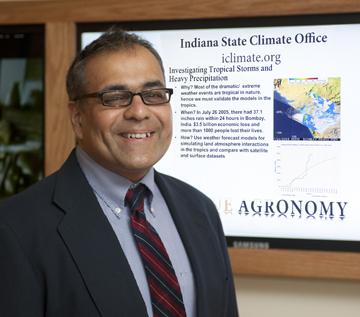

How cities shape climate and why smart urban design may help prevent natural disasters

Dev Niyogi is a professor of Agronony and EAPS
Cities are the “canary in the coal mine” of climate change. Because they’re so developed, they tend to be several degrees warmer than the surrounding areas, which means they can give us a glimpse into what our future will look like as the planet warms.
But cities aren’t only surrogates for future climate effects – they play another important role in climate change, because they can have a significant effect on the climate of the region they’re in. The size of the region impacted by a city may be many times greater than the size of the city itself.
An example of this is rainfall. If the development of a city in a certain location will direct rainfall away from a reservoir, the city may be forced into a drought. But directing rain to a reservoir can prevent flooding and potentially increase the city’s water supply.
Taking advantage of these opportunities requires using technology to understand the nuances of how cities shape the climate around them, which is where Purdue Professor Dev Niyogi comes in. Niyogi, a professor of agronomy and earth, atmospheric and planetary sciences, and the former state climatologist for Indiana, and his team are using computer simulations to better understand how cities modify the climate around them.
Niyogi will talk about his work at this year’s Dawn or Doom conference. The annual conference explores the risks and rewards of emerging technologies. Dawn or Doom ’18 will be held on Purdue’s West Lafayette campus Monday and Tuesday, Nov. 5-6. The conference, now in its fifth year, is free and open to the public.
In one project, his group is working with a group led by Daniel Aliaga, an associate professor of computer science, to design more realistic worlds for video gamers and in turn use the video game worlds to study how cities affect climate. The project initially began with Niyogi’s team helping the computer scientists quickly generate regionally representative weather for video games.
But along the way, he realized that the faux cities generated by the computer scientists also were useful in modeling how cities impact climate.
In another project called World Urban Data Analysis and Portal Tools (WUDAPT), Niyogi’s group is collecting data from citizen scientists about the weather and buildings in their city. He and Aliaga combine this crowd-sourced data with satellite data to create better models.
Dawn or Doom is aligned with Purdue's Giant Leaps Sesquicentennial Campaign and is part of the Ideas Festival theme, Giant Leaps in Artificial Intelligence, Algorithms, and Automation: Balancing Humanity and Technology. The Ideas Festival is the centerpiece of the campaign and connects world-renowned speakers and Purdue expertise in a conversation on the most critical problems and opportunities facing the world.
Writer: Adrienne Miller, science and technology writer, Information Technology at Purdue (ITaP), 765-496-8204, mill2027@purdue.edu


